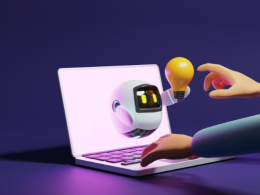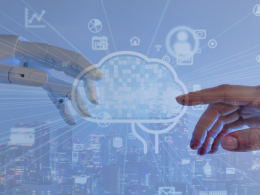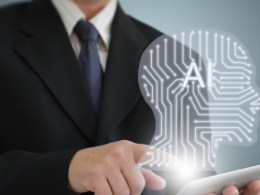Machine Learning and AI have become such buzzwords today that there are equal number of misconceptions about the field as much as there is excitement.
Our goal at Accredian is to help clear misconceptions at, we will bust common myths associated with ML and AI domain.
At the end of this article, you will be able to grasp the real potential and limits of this technology. Let’s get started.
2016’s Gartner hype cycle predicted machine learning to be at its peak of ‘Inflated expectations.’
Self-driving cars by Tesla, Google’s deep learning AI program Alphago, Chatbots like Cleverbot, and numerous other AI applications have drawn more people towards these exciting domains.
From personal assistants like Siri to airborne intelligent rescue drones, machine learning is unlocking a whole new world of possibilities. It is undeniable that smart machines have woven their roles intricately in our lives.
But, the subject is still surrounded by myths and misconceptions. Blame unrealistic technology hype and media misinterpretations for this.
Busting these myths will give us a closer and lucid picture of the fledgling technology.
Myth 1: ‘Machine learning’ is magic
Often portrayed as ‘magic’ in the pop culture, AI and ML are not new concepts.
Arthur Samuel first coined the term in 1959 at IBM.
ML is no magic .
It is just computers learning from and making predictions on Data.
Machine Learning comprises of data analysis, pattern recognition, and iteration.
Feed any computer with enough data to ‘train’ it, integrate a machine learning algorithm, and you get a rookie AI.
Myth 2: ML is same as AI
A commonly perpetuated myth is ML and AI being the same thing. We hear it all the time at Accredian.
Mainstream media might have confused you, but these are two different things.
However, both are closely associated.
AI is a computer system capable of making decisions based on learning.
An AI ‘trains’ on input data sets and learns via designed algorithms.
It requires human intervention as well as ‘train’ it.
On the flip side, Machine Learning (ML) algorithm powers the AI.
It enables a computer to learn without being explicitly programmed.
Myth 3: Machines learn autonomously
In fact, the opposite is true.
Machines do not know what to learn.
Machines do not understand how to learn.
Human programmers design the learning architecture for an AI.
The learning can be supervised, unsupervised or reinforced learning.
Then the machine is trained by programmers with tons of data.
This cumbersome process runs behind the scene while creating an AI system.
For example, while designing a ‘visual-recognition’ system for a driverless car, every possible object has to be fed to the training database.
From stones of varying sizes to humans, the list quickly grows gigantic.
Only after learning from this structured database an AI can give useful results.
Myth 4: Algorithms are everything
Media hypes have presented ‘Algorithms’ as the magic wand for AI.
They are essential components of ML but not ‘the most’ important though.
The quality and quantity of the training datasets are equally important.
An intelligent machine is impossible without TD, ML, and HITL (Training Data, Machine Learning & Human-in-the-loop) framework.
Also, people seem to relate AI algorithms with ‘human brain.’
It is another misconception.
Algorithms are based on sets of rules about ‘how the machine is supposed to study, learn and predict the given data set accurately.’
On the other hand, the human brain is associated with NI (Natural Intelligence).
The brain employs different learning and functioning processes than a computer does.
A mathematical code or algorithm cannot replicate these functions.
Hence, AI algorithms are not the replication of the human brain.
Myth 5: AI can undertake any task
Maybe one day AI can undertake any task but currently AI is still in infancy trying to augment human intelligence.
Present intelligent machines work by interpreting an input ‘A’ and generating an apt response ‘X’ for it.
With our current level of technology, an AI can identify a human figure.
But, it cannot be made to recognize its gender, emotions, mood, intentions, etc. all at once.
Such complex responses by a machine are only possible with evolved deep learning architecture that can ‘mimic’ human brain.
But, this lies too far into the future.
Another limit is the availability of large datasets, relevant to a scenario.
For an application to employ an AI system, availability of significant and clean data is essential for its training, tuning and great judgment accuracy.
But such data sets are scarce.
For example, to design an AI solution for predicting possibilities of extraterrestrial life, you would need relevant and extensive data set about the universe itself, all life forms, evolution, planetary systems, and numerous conditions for sustaining life, etc.
Creating and cleaning such a massive data set is inherently impossible.
Therefore, AI cannot be a solution everywhere.
The third limit of AI solutions is they cannot replace complex tasks as of now.
Take piloting an aircraft, performing surgery or starting a new business as examples.
These jobs require complex information processing and taking the best possible decision at all moments.
Current ML architectures limit the machines to do so.
Even if we do create robots capable of executing such tasks, human-in-the-loop intervention is indispensable.
To reduce risky outcomes and maintain high accuracy results, AI and humans will always work together.
At Accredian, we believe AI will continue taking away low skilled human jobs like telemarketing, proofreading, manufacturing, etc while the high complexity work will still be best done by humans.
Myth 6: ML can be applied in any paradigm
We wish it were true, at least in the present scenario.
Machine learning can only be implemented with great results in cases where ‘big data sets’ are available.
AI solution needs tons of data to train and learn.
Example, anti-spam bots require huge amount of data from online users to study their behavioral patterns and detect spam from ham.
They work successfully because ‘big data’ from emails are readily available.
In a scenario where data is scarce, the predictions made by the AI will be unreliable.
Hence, the scope of ML is limited by the availability of big data sets.
Myth 7: AI operates without human intervention
Frankly speaking, it is one fundamental limit on the present AI technology.
AI systems cannot work without human involvement.
Firstly, algorithm development demands our natural intelligence.
Secondly, a ‘Human-in-the-loop’ (HITL) workflow is required for high confidence results. Prediction outputs by an AI can be 70% accurate.
To make the accuracy higher at 98-99%, human intelligence is indispensable.
Present AI systems are not autonomous.
They require data labeling, tuning, and testing of the system’s prediction judgment by humans.
Myth 8-AI will soon attain Human level Natural intelligence (NI)
You might have come across the news that AI systems are growing far more intelligent than humans.
Sophia, the first citizen robot of the world certainly got you!
She is the most advanced humanoid AI to date.
While Sophia is an extraordinary feat, she is far from natural intelligence (NI) of humans.
Mimicking or simulating a person’s brain is a herculean task.
It took, for example, 40 minutes for Japan’s K-supercomputer to simulate 1 second of 1% of human brain activity.
No doubt machines are growing intelligent every day.
But they won’t be attaining human level intelligence anytime soon.
Other perspective says we might be comparing ‘abilities’ of machines and humans, not necessarily intelligence.
Intelligence in both the cases is defined differently.
For example, you can easily identify a tiger from zebras or intuitively ‘know’ a person’s mood but not solve ‘Complex matrices’ in a fraction of seconds.
An AI can process chunks of large complex data millions of times faster than humans.
Like, beating a person in the game of ‘Go.’
But the same machine does not ‘know’ what to do when a baby is crying.
NI gives mammals an edge to face unseen life situations.
They can decide when what and how to do anything according to a situation.
AI cannot attain or ‘exceed’ natural mental abilities.
But it can be immensely capable.
Myth 9: ML can make AI predict future events
This one is a commonly misunderstood statement by the people.
Yes, AI systems are designed to ‘predict’ the outcome of a data input.
In a sense, it predicts future.
But not as you might think!
An AI simply outputs the ‘probability’ distribution or likelihood of an event to occur specifically.
This prediction is based on what the machine has learned from the training data.
Example, Ask an AI ‘when will I die?’
It won’t be able to predict that.
But input info like your age, sex, smoking habits, weight, geography, etc. and it will be able to predict the most likely time and cause of your death.
The result will come in comparison to the data set of death stats worldwide.
It is just an example of ‘how the machine predicts.’
No hard feelings!
Myth 10- ML cannot predict ‘Black swans’
‘Black Swans’ are those unforeseen events that have a major impact and are inappropriately reasoned.
Example of a black swan event is Chernobyl nuclear disaster.
Such happenings are extremely difficult to predict.
It is a prevalent notion that AI machines cannot predict black swan events.
Surprisingly, the opposite is true.
ML can predict rare events with uncanny accuracy.
Like it did for the 2008 Housing crash in the USA. While banks were reliant on flawed financial models, AI systems foresaw the crisis.
So to say, ML can predict Black swan events.
This is one true ‘superpower’ of this technology.
Myth 11: ML will create silicon Gods
Apocalyptic fantasies do give us an unparalleled rush!
Scientists aim to create AI machines that can ‘mimic’ general human intelligence autonomously.
But these machines won’t be turning us into dust.
They mean well.
The misconception might have born from this idea.
That ‘self-learning’ machines will become ‘autonomous.’
Once they ‘surpass’ human intelligence, they will find a reason to annihilate us.
Pure fantasy it is.
ML is enabling AI to complement humans for a better future.
Imagine a robot working on an oil-rig, precisely manufacturing tools, monitoring epidemic spreads or even diffuse a bomb.
We are building AI for automation, risk reduction, event prediction and accident prevention.
The probability of ‘silicon Gods’ ruling us is almost 0.
Myth 12-ML will make AI conscious in the future
This one goes for a good movie or book recipe.
Anticipating conscious and emotional reasoning machines soon surely gives us chills.
However, it won’t be real for next few centuries.
Consciousness and intelligence are different concepts.
You can prove intelligence but not consciousness.
A machine can be made to learn and take action.
All depends on the data it has been trained with.
But we still can never map why machine gave a particular ‘reasoning’ based on that data.
Humans can give reasons for their actions because they are ‘conscious.’
So expect conscious and emotional robots only in sci-fi movies for now.
Although, the ‘morality’ of ‘autonomous machines’ is a challenge to be solved. I
t is the ‘black box’ problem with AI.
Myth 13-Underestimating ML’s current achievements
Busting some ‘fancy’ sounding myths about AI might have disappointed you a little.
But all is not lost.
You should not underestimate what AI has already done.
Speech recognizing bots, natural language generators like Lucidworks, Deep learning neural networks, autopilot cars like Tesla model S, virtual assistants like Cortana and Siri and cognitive reasoning platforms like Rainbird have just arrived.
Though, once any AI solves a problem intelligently, people start disregarding it as ‘not real thinking by a computer.’
This is the ‘AI effect.’
Subtract the unrealistic expectation, and we get an awe-inspiring picture.
Gradually, we will be creating more sophisticated machines that will touch our fancy imagination.
Final Thoughts
These were the myths that we found necessary to be addressed about machine learning and artificial intelligence.
Some misconceptions were born out of unrealistic expectations, while some resulted from the misinterpretation of information.
You might now have a clear picture of machine learning and its association with the artificial intelligence.
Perhaps, you can share some insights and opinions on this topic with us.
Over to you
What do you think about ML and its future? Let us know in the comment box below! Accredian Research team is always eager to hear from you.





